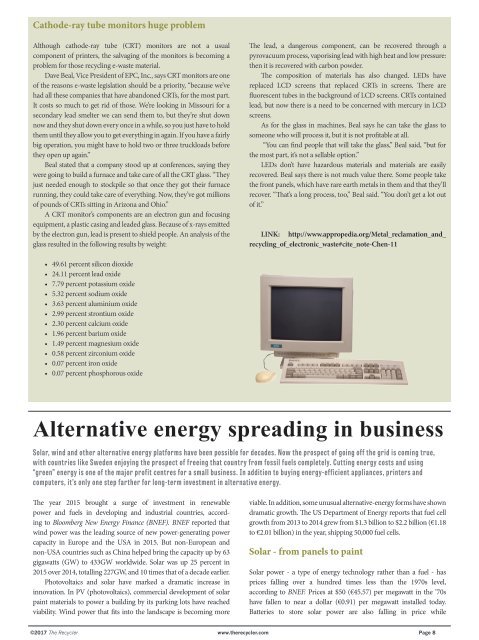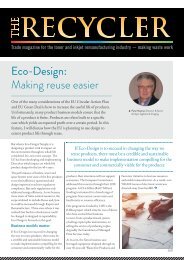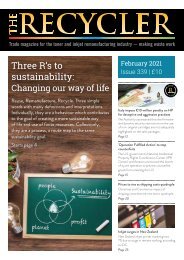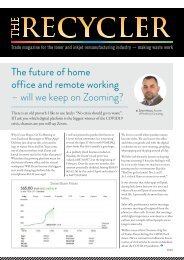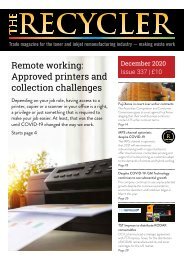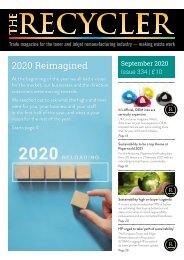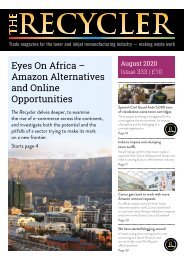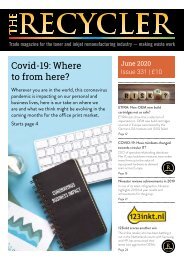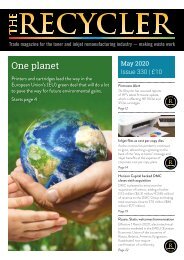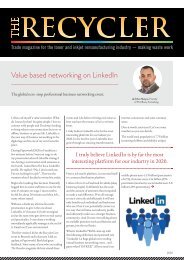Wide Format news 1-2017
You also want an ePaper? Increase the reach of your titles
YUMPU automatically turns print PDFs into web optimized ePapers that Google loves.
Cathode-ray tube monitors huge problem<br />
Although cathode-ray tube (CRT) monitors are not a usual<br />
component of printers, the salvaging of the monitors is becoming a<br />
problem for those recycling e-waste material.<br />
Dave Beal, Vice President of EPC, Inc., says CRT monitors are one<br />
of the reasons e-waste legislation should be a priority, “because we’ve<br />
had all these companies that have abandoned CRTs, for the most part.<br />
It costs so much to get rid of those. We’re looking in Missouri for a<br />
secondary lead smelter we can send them to, but they’re shut down<br />
now and they shut down every once in a while, so you just have to hold<br />
them until they allow you to get everything in again. If you have a fairly<br />
big operation, you might have to hold two or three truckloads before<br />
they open up again.”<br />
Beal stated that a company stood up at conferences, saying they<br />
were going to build a furnace and take care of all the CRT glass. “They<br />
just needed enough to stockpile so that once they got their furnace<br />
running, they could take care of everything. Now, they’ve got millions<br />
of pounds of CRTs sitting in Arizona and Ohio.”<br />
A CRT monitor’s components are an electron gun and focusing<br />
equipment, a plastic casing and leaded glass. Because of x-rays emitted<br />
by the electron gun, lead is present to shield people. An analysis of the<br />
glass resulted in the following results by weight:<br />
The lead, a dangerous component, can be recovered through a<br />
pyrovacuum process, vaporising lead with high heat and low pressure:<br />
then it is recovered with carbon powder.<br />
The composition of materials has also changed. LEDs have<br />
replaced LCD screens that replaced CRTs in screens. There are<br />
fluorescent tubes in the background of LCD screens. CRTs contained<br />
lead, but now there is a need to be concerned with mercury in LCD<br />
screens.<br />
As for the glass in machines, Beal says he can take the glass to<br />
someone who will process it, but it is not profitable at all.<br />
“You can find people that will take the glass,” Beal said, “but for<br />
the most part, it’s not a sellable option.”<br />
LEDs don’t have hazardous materials and materials are easily<br />
recovered. Beal says there is not much value there. Some people take<br />
the front panels, which have rare earth metals in them and that they’ll<br />
recover. “That’s a long process, too,” Beal said. “You don’t get a lot out<br />
of it.”<br />
LINK: http://www.appropedia.org/Metal_reclamation_and_<br />
recycling_of_electronic_waste#cite_note-Chen-11<br />
• 49.61 percent silicon dioxide<br />
• 24.11 percent lead oxide<br />
• 7.79 percent potassium oxide<br />
• 5.32 percent sodium oxide<br />
• 3.63 percent aluminium oxide<br />
• 2.99 percent strontium oxide<br />
• 2.30 percent calcium oxide<br />
• 1.96 percent barium oxide<br />
• 1.49 percent magnesium oxide<br />
• 0.58 percent zirconium oxide<br />
• 0.07 percent iron oxide<br />
• 0.07 percent phosphorous oxide<br />
Alternative energy spreading in business<br />
Solar, wind and other alternative energy platforms have been possible for decades. Now the prospect of going off the grid is coming true,<br />
with countries like Sweden enjoying the prospect of freeing that country from fossil fuels completely. Cutting energy costs and using<br />
“green” energy is one of the major profit centres for a small business. In addition to buying energy-efficient appliances, printers and<br />
computers, it’s only one step farther for long-term investment in alternative energy.<br />
The year 2015 brought a surge of investment in renewable<br />
power and fuels in developing and industrial countries, according<br />
to Bloomberg New Energy Finance (BNEF). BNEF reported that<br />
wind power was the leading source of new power-generating power<br />
capacity in Europe and the USA in 2015. But non-European and<br />
non-USA countries such as China helped bring the capacity up by 63<br />
gigawatts (GW) to 433GW worldwide. Solar was up 25 percent in<br />
2015 over 2014, totalling 227GW, and 10 times that of a decade earlier.<br />
Photovoltaics and solar have marked a dramatic increase in<br />
innovation. In PV (photovoltaics), commercial development of solar<br />
paint materials to power a building by its parking lots have reached<br />
viability. Wind power that fits into the landscape is becoming more<br />
viable. In addition, some unusual alternative-energy forms have shown<br />
dramatic growth. The US Department of Energy reports that fuel cell<br />
growth from 2013 to 2014 grew from $1.3 billion to $2.2 billion (€1.18<br />
to €2.01 billion) in the year, shipping 50,000 fuel cells.<br />
Solar - from panels to paint<br />
Solar power - a type of energy technology rather than a fuel - has<br />
prices falling over a hundred times less than the 1970s level,<br />
according to BNEF. Prices at $50 (€45.57) per megawatt in the ’70s<br />
have fallen to near a dollar (€0.91) per megawatt installed today.<br />
Batteries to store solar power are also falling in price while<br />
©<strong>2017</strong> The Recycler www.therecycler.com Page 8


